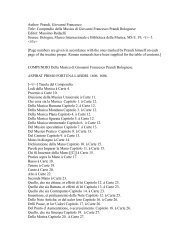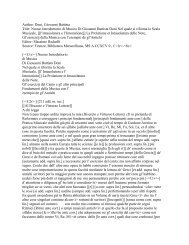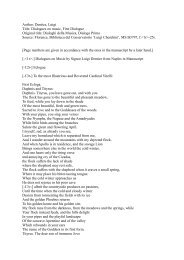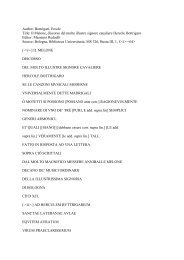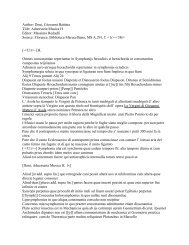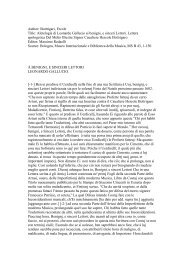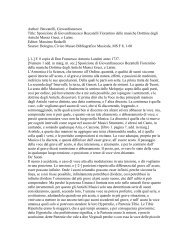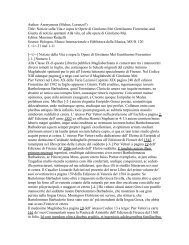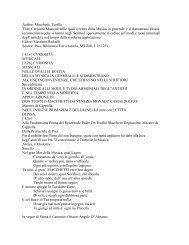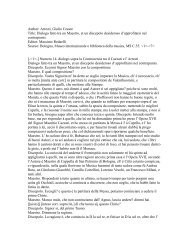Author: Doni, Giovanni Battista - manuscripts of italian music theory ...
Author: Doni, Giovanni Battista - manuscripts of italian music theory ...
Author: Doni, Giovanni Battista - manuscripts of italian music theory ...
Create successful ePaper yourself
Turn your PDF publications into a flip-book with our unique Google optimized e-Paper software.
diaireseon to idion ekphainein ei me tis eis ton touton syntonoteron spondeisomn;<br />
blepon auto touto diatonon einai apeikase; delon d'hoti kai pseudos kai ekmeles thesei<br />
ho toiouto ditheis; pseudos men hoti diesei elatton esti tonou tou peri ton egemona<br />
keimenou; ekmeles de hoti kai eitis en te tou toniaou dynamei tithesi to tou<br />
syntonoterou spondeiasmou idion sumbanoi anduo exes tithesthai diatona to men<br />
asyntheon to de syntheton; to gar en tais mesais enarmonion pyknon ho nyn khrontai<br />
ou dokei tou poietou einai. rhadion d'esti synidein ean tis archaikos tinos aulountos<br />
akouse; asyntheton gar bouletai einai to en tais mesais hemitonion; ta men oun prota<br />
[--] ton enarmonion toiauta; hysteron de to hemitonion dierethe en te tois<br />
Lydiois kai en tois Phrygiois; phainetai d'olympos auxesas mousiken to agenneton ti<br />
kai agnoumenon hypo ton emprosthen eisagogein kai archegos genesthai tes Ellenikes<br />
kai kales mousikes]. This is the translation: “In fact he did not practice what is<br />
specific <strong>of</strong> the Diatonic or what is specific <strong>of</strong> the Enharmonic, since these are the<br />
foundations o the Enharmonic. Firstly, they place the Spondaeus among these<br />
intervals, in which none <strong>of</strong> the Divisions demonstrates its own being. If then someone<br />
looked at higher Spondiasmus and did not judge that that is Diatonic, it is clear,<br />
however, that whoever will harbour this opinion, will judge it as the false and<br />
unsingable one. I say the false one, because said interval will be found to be smaller<br />
than a Diesis than the tone placed in the first and main place, and unsingable, because,<br />
albeit someone will place the highest Spondiasmus in the interval and proportion <strong>of</strong><br />
the Tone, what will happen is that two diatonic intervals, one uncompounded and one<br />
compounded, will happen to be placed one next to the other. Therefore, it does not<br />
seem to me that the Enharmonic Thick practised today can be attributed to said<br />
Inventor, and it will be easy to understand this if one listens someone who plays the<br />
flute in the antique style, because that semitone <strong>of</strong> the Mese wants to be<br />
uncompounded. Therefore, these were the beginnings and the foundations <strong>of</strong> the<br />
Enharmonic. It appears, therefore, that Olympus enlarged <strong>music</strong> and introduced<br />
elements which were not known and did not exist earlier, was the first author <strong>of</strong> the<br />
Greek and beautiful <strong>music</strong>.” Since all these facts are very notable and interesting, as<br />
all <strong>of</strong> those that Plutarch teaches us, it is right that we should explain them as well as<br />
it shall be possible, [--] because they provide us with much information about<br />
ancient <strong>music</strong> in a few words. Firstly, one has to know that Spondaeus and<br />
Spondiasmus in this passage do not mean the foot or the Rhythm <strong>of</strong> the Spondaeus,<br />
which contains two long ones, but an harmonic interval <strong>of</strong> three dieses, or three<br />
quarters <strong>of</strong> a Tone. Aristides is the only one who teaches us this, to my knowledge, as,<br />
without him, we would be unaware <strong>of</strong> something very essential in ancient Music.<br />
However, since Zarlino did not observe this, he was convinced with great probability<br />
that Rhythm was part <strong>of</strong> the essence <strong>of</strong> the ancient Tones or Modes, but we shall show<br />
elsewhere that this is false. Therefore, one must know that said term has various<br />
interpretations and meanings related to each other, since, not only it means the metric<br />
commonly called Spondaeus by the Grammarians, but also the Rhythm which uses<br />
that foot and also the song or the air which was used in the sacrifices. In that case, it is<br />
accompanied, as an adjective, to the word [melos]. This was not only slow and<br />
solemnly measured as to its Rhythm, but it adopted also slow intervals and difficult to<br />
pitch, such as those <strong>of</strong> three dieses. Therefore, that interval as well was called<br />
Spondaeus and its use was called Spondaismus. So, Aristoxenus says that Olympus<br />
did not have any knowledge <strong>of</strong> the proper and well ordered disposition <strong>of</strong> the genera<br />
which artists established later on, which have their tetrachords ordered and laid out as<br />
we have seen above, but that the foundations <strong>of</strong> his Enharmonic [--] appeared<br />
to be as we shall endeavour to show with this illustration, since they can be deduced



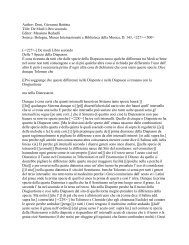
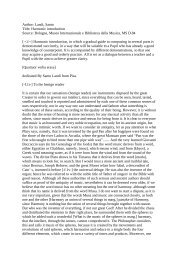
![Doni, Giovanni Battista Title: Trattato Dei Tuoni o [[Harmonie de]]](https://img.yumpu.com/45461005/1/190x245/doni-giovanni-battista-title-trattato-dei-tuoni-o-harmonie-de.jpg?quality=85)
